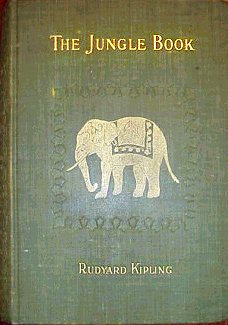
The Jungle Book (1894) is a collection of stories written by Rudyard Kipling and inspired by his frequent trips to India. All of the stories were published in magazines in 1893-4. The best-known of them are the three stories revolving around the adventures of an abandoned 'man cub' Mowgli who is raised by wolves in the Indian jungle. The most famous of the other stories are probably "Rikki-Tikki-Tavi", the story of a heroic mongoose, and "Toomai of the Elephants", the tale of a young elephant-handler.
The Second Jungle Book followed in 1895.
The Jungle Book is used as a motivational book by the Cub Scouts, a junior element of the Scouting movement. This use of the book's universe was approved by Kipling after a direct petition of Baden-Powell, founder of the Scouting movement.
Stories in The Jungle Book:
The complete book, having passed into the public domain, is on-line at Project Gutenberg's official website and elsewhere.
- "Mowgli's Brothers": A boy is raised by wolves in the Indian Jungle with the help of Baloo the bear and Bagheera the panther, and then has to fight the tiger Shere Khan. This story has also been published as a short book in its own right.
- "Kaa's Hunting": This story takes place before Mowgli fights Shere Khan. When Mowgli is abducted by monkeys Baloo and Bagheera set out to rescue him with the aid of Chil the Kite and Kaa the python.
- "Tiger! Tiger!": Mowgli returns to the human village and is adopted by Messua and her husband who believe him to be their long-lost son Nathoo. But he has trouble adjusting to human life, and Shere Khan still wants to kill him. The story's title is taken from the poem "The Tyger" by William Blake.
- "The White Seal": Kotick, a rare white-furred seal, searches for a new home for his people, where they will not be hunted by humans. The story may be considered an allegory for the Zionist movement, whose efforts to find a Jewish homeland started in the same decade when Kipling wrote the book.
- "Rikki-Tikki-Tavi": Rikki-Tikki the mongoose defends a human family living in India against a pair of cobras. This story has also been published as a short book.
- "Toomai of the Elephants": Toomai, a ten-year old boy who helps to tend working elephants, is told that he will never be a full-fledged elephant-handler until he has seen the elephants dance. This story has also been published as a short book.
- "Her Majesty's Servants" (originally titled "Servants of the Queen"): On the night before a military parade a British soldier eavesdrops on a conversation between the camp animals.
Adaptations
The book's text has often been abridged or adapted for younger readers, and there have also been several comic book adaptations.
Live-action film versions
- Jungle Book (1942 film) - directed by Zoltán Korda, starring Sabu as Mowgli
- The Jungle Book (1994 film) - starring Jason Scott Lee as Mowgli
- The Second Jungle Book: Mowgli and Baloo (1997) - starring Jamie Williams as Mowgli
- The Jungle Book: Mowgli's Story (1998) - starring Brandon Baker as Mowgli
- "Toomai of the Elephants" was filmed as Elephant Boy, also starring Sabu. In the 1960s there was a television series of the same name, loosely based on the story and film.
Animation
- There are several Disney animated adaptations based very loosely on the Mowgli stories. (Adaptations of The Jungle Book tend to concentrate on Mowgli's adventures). It has also been filmed several times with varying degrees of authenticity. Disney's 1967 animated film version, based loosely on the Mowgli stories, was extremely popular, though it took great liberties with the plot and characters.
- Chuck Jones' made for TV cartoons Mowgli's Brothers, Rikki-Tikki-Tavi and The White Seal stick to the original storylines more closely than most adaptations.
- There was a Japan]]ese anime television series called Jungle Book Shonen Mowgli broadcast in 1989. Its adaptation represents a compromise between the original stories and the Walt Disney version. Many of Kipling stories are adapted into the series, but many elements are combined and changed to suit more modern sensibilities. For instance, Akela, the wolf pack alpha eventually steps aside, but instead of being threatened with death, he stays on as the new leader's advisor. Also, there is an Indian family in the series which includes Rikki-Tikki-Tavi as a pet mongoose. Finally at the series' conclusion, Mowgli leaves the jungle for human civilization, but still keeps strong ties with his animal friends.
The Japanese anime was dubbed in Hindi and telecast as "Jungle Book" by Doordarshan in India during the early 90's. The Indian version featured original music by Vishal Bharadwaj (with words by noted lyricist Gulzar) and a very good choice of dubbing artistes for the voice acting, which made it quite popular among television series of that time.
See also
- Works of Rudyard Kipling
- The Jungle Book characters
- The Third Jungle Book
- Feral children
- Feral children in mythology and fiction
External links
- The Jungle Book Collection: a website demonstrating the variety of merchandise related to the book and film versions of The Jungle Books.
- Template:Gutenberg